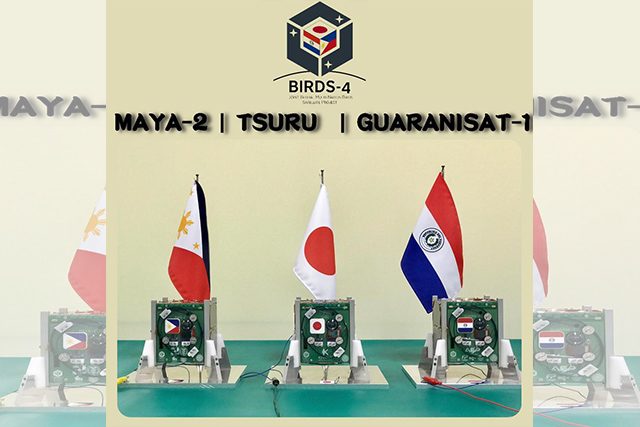
The second Philippine cube satellite (CubeSat) was finally launched into space last Sunday.
While Filipino science enthusiasts cheered for the historic moment, some social media users downplayed this feat and poked fun at the cube-sized satellite instead.
The second Maya
Called Maya-2, the country’s second 1U CubeSat boarded the S.S. Katherine Johnson Cynus spacecraft which then sent it into the International Space Station at 1:36 a.m. last Sunday.
Maya-2 was joined by other 1U-sized cube satellites from Japan (Tsuru) and Paraguay (GuaraniSat-1) as part of the Northrop Grumman CRS-15 mission.
The Department of Science and Technology’s Space Technology and Applications Mastery, Innovation and Advancement (STAMINA4Space) program explained that Maya-2 is an improved version of Maya-1, which was decommissioned on Nov. 23, 2020.
“Apart from the similarity of the platforms, Maya-2 was developed and improved using the knowledge gained from developing its predecessor,” read the statement from STAMINA4Space.
STAMINA4Space leader Dr. Maricar Soriano further explained the CubeSat research could impact Filipinos through the following:
- A systems engineering mindset among our researchers
- Local partners that can co-develop our space industry
- Enhanced Science Technology and Engineering curricula in K-12 and higher education
Philippine Space Agency Director General Joel Joseph Mariano Jr. likewise praised this breakthrough.
“To do something for the first time is great, but to be able to do it again and innovate is greater. We take pride in the launch of Maya-2, the successor to Maya-1 and the Philippines’ latest milestone in creating value in space for and from Filipinos and for the world,” Mariano said in a statement.
Why is Maya-2 small?
Maya-2 has the same size as the other two CubeSat units, with the following dimensions: 10cm × 10cm × 10cm.
They were developed under the 4th Joint Global Multi-Nation Birds Satellite (BIRDS-4) Project of the Kyushu Institute of Technology (Kyutech) in Japan.
Canadian Space Agency said CubeSat is a square-shaped miniature satellite with roughly the same size of a Rubik’s cube. It weighs about 1 kilogram and “can be used alone (1 unit) or in groups of multiple units (maximum 24 units).”
“Satellites have become smaller for a number of reasons, the first being the cost associated with assembly and launch,” the CSA said.
Despite being small, CubeSats have important functions. Among these are:
- Test commercial off-the-shelf components, as well as new technologies such as Perovskite solar cell and antenna using the satellite structure to prove their worthiness in space.
- Gather data from ground sensors for weather and infectious disease analysis.
CSA also noted that CubeSats are easier to build with the following advantage:
- Fast: can be built within two years
- Cost: far less expensive than large satellites
- Technology: simple, standard parts available off-the-shelf
- Design: simple design for short mission; no need to use thermal blankets
- Space debris: none – they burn up in the atmosphere upon re-entry
Maya-2, in particular, was developed by three Filipino engineers—Mark Angelo Purio, Izrael Zenar Bautista and Marloun Sejera.
They were sent to Japan through DOST’s Space Science and Technology Proliferation through University Partnerships (STep-Up) of the STAMINA4Space program.
The Facebook page of STAMINA4Space also shared that Maya-2 was named after a bird with a similar height as the satellite.
How the public reacted
Local science organization Earth Shaker was among those that first shared about the second CubeSat launch on social media.
There were, however, comments on Facebook that appeared to mock and belittle Maya-2.
“Oh great, a new addition to space junk,” one user said.
A Reddit user also posted a screenshot of a news item showing laugh reactions to the report.
Congrats to all of those who worked on this achievement more power sainyo mga maam and sir wag nyo po pansinin ung natawa sainyo from r/Philippines
Some Reddit users in the forum attributed such reactions to the lack of funding and support in educating the public about the space industry.
“Imagine if Filipino researchers are given more funding, we can achieve bigger than this. Kulang talaga sa suporta kaya how dare these people do a ‘laugh react,’” one user said.
“For those laughing about this, hindi ito pinagtatawanan. Unless kaya niyong mag-design ng hardware na kayang i-tolerate ang extreme temperatures and radiation levels, tumahimik kayo,” another wrote.
They also congratulated the engineers behind Maya-2.
“NASA was able to land Perseverance in Mars last Friday. Now, we have Maya-2 launched into space. This was a great weekend for Filipino Space Enthusiasts,” one Reddit user said.





